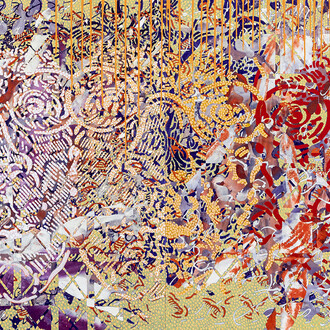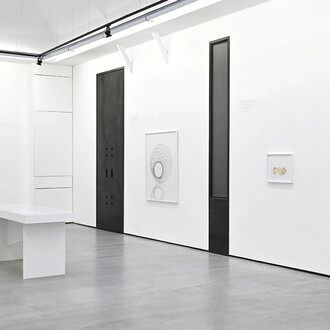The exhibition Corpus presents an ensemble of works—painting, photography, video and drawing—produced by the artist from the 1960s to the present day. In these works, the body registers, occupies and defines the space and plays a central role. The exhibition has a retrospective dimension, spanning the different phases of the artist’s career, from her earliest pieces dating from the mid-1960s up until her more recent work.
Following her early three-dimensional works, the artist found in photography a means of overcoming the exteriority of painting, and of allowing “being” and “doing” to coexist in the same medium, “as if I were continuing to affirm: my painting is my body, my work is my body”. Beyond the poetic and metaphorical readings that this work can inspire, it can be seen as an attempt at attaining the limits of a medium, whether photography, performance or sculpture.
The body in Almeida’s work becomes both a sculptural form and a space, object and subject, signifier and signified. The artist’s work is a summary, an act that has been carefully staged, and one that is highly poetic. The representations of these actions also show the context in which Almeida positioned herself. Facing the camera, she refuses that her pictures become self-portraits. She represents primarily her body, but it is a universal body.
Dressed in black, Helena Almeida incorporates elements from her studio into her pictures. She takes position in poses that she has carefully choreographed, in order to create complex compositions, which are often organized in series. In 1969, for the first time, Helena Almeida was photographed by her husband, the architect Artur Rosa. The latter would frequently collaborate with her, as the photographer of his wife’s performances, a highly mediatized form of self-representation, which would become a characteristic of her work.
Unlike other contemporary artists who use the self-portrait and self-representation to stage characters through elaborate sets and poses—Cindy Sherman, for example—here the starting point is always the artist’s body. Through photography, Helena Almeida creates a strong relationship between representation (the act of painting or drawing) and presentation (of her own body as a “medium” of that act). “The real physical body of the artist is constantly lost, defaced or obscured behind streaks of paint which sometimes extend it, sometimes cover it, enter or exit (towards or away from) the interior of this body.”
Her more recent works can be characterized by the relationship between the artist’s body and space (no longer with drawing or painting), and makes use of photography (recurrent in works composed of series) in order to retrace a performance of the artist within the private space of her studio. Nevertheless, the same question continues to underlie Helena Almeida’s work: how can the body and the movement of the body (always that of the artist) succeed in creating a work of art? The intransigence with which Helena Almeida explores this subject makes her oeuvre, according to Isabel Carlos, «one of the most radically consistent of Portuguese art from the second half of the twentieth century».
Helena Almeida is a Portuguese artist known for her photographic work, in addition to her performances, paintings and drawings. Born in 1934 in Lisbon, where she still lives and works today, Helena Almeida studied painting at the Fine Arts Department of the University of Lisbon in 1955. She regularly exhibited her work from the late-1960s onward. Her father, the sculptor Leopoldo de Almeida, encouraged her to participate in his studio sessions.
Following her marriage to architect Artur Rosa, Helena Almeida received a scholarship and moved to Paris. Her first exhibition took place in 1967. Her earliest three-dimensional work reveals her diverse range of influences and undermined traditional concepts of painting. From 1969 onward, Helena Almeida began to work on the notion of self-representation. According to Almeida, there are no limits between the work and the body of the artist. However, her works are not self-portraits, but instead vacillate between performance, capturing a fixed moment in time, and body art, where her body is the subject of the work.
In the early-1970s, Helena Almeida returned to drawing and three-dimensional works, with the use of horsehair, in order to create the impression of movement within the work. From 1975 onward, she combined three disciplines; photography, painting and drawing, using either horsehair or blue and red paint, or black pigment on her photographs. Exhibitions of her work have been held in various venues and locations hroughout the world: Kettle’s Yard in Cambridge (2009), Fundación Telefónica in Madrid (2008), The Drawing Center in New York (2004), Biennale of Sydney (2004) and the Galician Contemporary Art Centre (CGAC) in Santiago de Compostela (2000). Such visibility on an international scale has contributed to the artist’s renown outside of her native Portugal. Almeida now holds an eminent place on the international art scene. She represented Portugal at the Venice Biennale in both 1982 and 2005.
![Helena Almeida, Pintura habitada [Peinture habitée], 1975, Acrylique sur photographie, 46 x 50 cm. Collection Fundação de Serralves – Museu de Arte Contemporânea, Porto. Foto Filipe Braga. © Fundação de Serralves, Po](http://media.meer.com/attachments/9b5cd4fc04e402fd4bcdf27d5066c8f9d3d133d9/store/fill/1230/692/4fcd04f1f1dc3541119d70ce7aec725dcc3e95af084cf8ba99fde9d5de7d/Helena-Almeida-Pintura-habitada-Peinture-habitee-1975-Acrylique-sur-photographie-46-x-50-cm.jpg)

![Helena Almeida, Saída negra [Sortie noire]
1995, Photographie noir et blanc (5 éléments), 71 × 48 cm (chaque), Coll. Norlinda and José Lima, long-term loan to Núcleo de Arte da Oliva Creative Factory, S. João da Madeira.
Photo Aníbal Lemos, courtesy Núcleo de Arte da Oliva Creative Factory, S. João da Madeira](http://media.meer.com/attachments/1449b2b5bdc368d05b3ef90e0674cbc0944ffd2e/store/fill/410/615/21ee75d232b1ae9e665ef52fe10bca9786b0574a8f7d964b5c3c2784cff3/Helena-Almeida-Saida-negra-Sortie-noire-1995-Photographie-noir-et-blanc-5-elements-71-x-48-cm.jpg)
![Helena Almeida, Seduzir [Séduire], 2002
Photographie noir et blanc (2 éléments), 187 × 125 cm (chaque). Coll. Helga de Alvear, Madrid/Cáceres. Photo Laura Castro Caldas and Paulo Cintra, courtesy Galería Helga de Alvear, Madrid/Cáceres](http://media.meer.com/attachments/a8c7401f784db2a60aedfdf198eedb498e07bf9d/store/fill/410/615/5399bec3588d9874009257738341f8431b5cff143dc2d6a0965f16f5c033/Helena-Almeida-Seduzir-Seduire-2002-Photographie-noir-et-blanc-2-elements-187-x-125-cm-chaque.jpg)
![Helena Almeida, Saída negra [Sortie noire]
1995, Photographie noir et blanc (5 éléments), 71 × 48 cm (chaque), Coll. Norlinda and José Lima, long-term loan to Núcleo de Arte da Oliva Creative Factory, S. João da Madeira.
Photo Aníbal Lemos, courtesy Núcleo de Arte da Oliva Creative Factory, S. João da Madeira](http://media.meer.com/attachments/04afe91e914fca21f65991863d8385f115457c95/store/fill/410/615/7154510cd261a8b4ef0ad33ae9672485a8a6326857a28adf475b7087e4ba/Helena-Almeida-Saida-negra-Sortie-noire-1995-Photographie-noir-et-blanc-5-elements-71-x-48-cm.jpg)

![Helena AlmeidaSaída negra [Sortie noire]
1995, Photographie noir et blanc (5 éléments), 71 × 48 cm (chaque), Coll. Norlinda and José Lima, long-term loan to Núcleo de Arte da Oliva Creative Factory, S. João da Madeira. Photo Aníbal Lemos, courtesy Núcleo de Arte da Oliva Creative Factory, S. João da Madeira](http://media.meer.com/attachments/338938b6f558da0c3920f7a41666ea22ccb82b70/store/fill/410/615/f5a29cc11c8b8acbe5c8ffc8a401a9c574b88cfa89d9990afb69651f9b10/Helena-AlmeidaSaida-negra-Sortie-noire-1995-Photographie-noir-et-blanc-5-elements-71-x-48-cm.jpg)
![Helena Almeida, Dentro de mim [À l’intérieur de moi] 1998, Photographie noir et blanc, 185 × 122 cm. Coll. Fundação Luso-Americana para o Desenvolvimento, en dépôt à la Fundação de Serralves – Museu de Arte Contemporânea, Porto. Photo : Laura Castro Caldas et Paulo Cintra, courtesy FLAD, Lisbonne](http://media.meer.com/attachments/213e629ff7229b5f3eace04c361acc5adc14eb8c/store/fill/410/615/3cec7eb6f59c69a736e889cef6177159d960e4179638ea832d662bebca28/Helena-Almeida-Dentro-de-mim-A-linterieur-de-moi-1998-Photographie-noir-et-blanc-185-x-122-cm.jpg)











